|
|
|
| .
NOTICE. You are on the 2017 site and this entire course has been updated and is now published on our new 2018 interactive platform. You will need a different user name and password to access the new platform… but we strongly suggest you LOGIN HERE and enjoy the new improved latest interactive content of this course. http://courses.handwritinguniversity.com/ Register for this course on the new platform here; http://courses.handwritinguniversity.com/p/beginner-s-course-on-personality-through-handwriting-analysis-level-100
LESSON . One of the most common reasons people want to use handwriting analysis in their life is to find out how intelligent somebody is, how ethical they are, and they want to know how compatible they would be in a romantic or business situation. Are You Smart? Intelligence is the capacity to learn, to reason, and to retain knowledge. The ability to be creative and the ability to be analytical are different forms of intelligence. The words smart and dumb are poor indicators of any real intellectual capacity, or lack thereof, in a person. However, when we were young, we were probably labeled smart or dumb in our minds and spent the rest of our schooling proving ourselves right. Since, by our definition, intelligence is the capacity to learn, our formal level of education has little to do with how intelligent we are. In my opinion, psychologists do a tremendous disservice to young people by labeling them with an IQ score. Now, after decades of using this standardized intelligence test, IQ tests have been almost completely discredited as an accurate and predictable indicator of intelligence. Obviously, “smart” people have different thinking processes from those we perceive as “dumb.” The difference lies not in their brain capacity, but in how they think. The important issue is the method used to process and sort information — the education they possess has little to do with intelligence. Numerous research studies have found no correlation between getting good grades and achieving financial success. Our more in-depth courses discuss three basic groups of thinking patterns: Cumulative, Investigative, and Comprehensive. Then we will look at some variations of these three basic patterns. The thinking patterns are shown in the middle zone letters m, n, h, and even r. However, most of your information will come from the lowercase letters m and n. You will be looking at the way the upper humps are formed: curved, pointed, or retraced. You also will be looking at the way the down-strokes are formed: v-shape, looped, retraced, etc. In each of these strokes, you will be able to determine a different aspect of the person’s method of thinking. Just observe the strokes of the letter to determine the pattern. I noticed something interesting when I was in school. During high school and college, both valedictorians of my class were cumulative thinkers. I knew both women fairly well. And, between you and me, they weren’t the sharpest people I’ve ever met. In fact, they were average or below average in common sense. But they did master the skills of studying, memorizing, and testing in the American school system. Most US-based school systems are designed for the student to examine the material, memorize it, and then regurgitate it on a test. The process leaves the probing, investigative student totally bored out of his mind, because he has to wait on the slowest student in class. In many cases, the child with the greatest natural ability to synthesize information and think creatively is stuck in a system designed for students to only achieve minimal requirements. You already know intelligence has absolutely nothing to do with getting high grades in school. Getting great grades involves such factors as motivation, attitude, interest, and self-discipline. The cases of learning difficulties are usually a matter of instructors teaching ineffective thinking and learning strategies. If teachers could present information in a style appropriate and conducive to each individual student’s learning patterns, we wouldn’t have so many delinquent students. Learn about your own thinking pattern and learn within that style. If you have a cumulative style, take one step at a time; on the other hand, if you are super-exploratory, jump into the middle and gather all the facts as fast as you can, in any order you like. Cumulative Thinker The slowest of the thinking patterns is the cumulative thinker. This is shown in the humps of the letters m and n. The more curved and round these letters are, the longer it takes for the writer to absorb information. However, once this person learns something, he tends to remember it much longer than the fast, comprehensive thinkers. If a letter m, n, h, or r is made in a slow, round, gentle fashion, the writer is ordinarily gentle and slow as well. This person is a cumulative and often creative thinker. (Creativity is found in people with all three types of humps.) She likes to have all the facts before making a decision. She thinks or creates much like a mason, stacking fact upon fact. Her thought pattern, the conclusion, will not be complete until the last fact is in place. This writer learns faster through demonstration than through written or verbal directions. She also learns more easily by experiencing something herself, instead of by observing someone else doing it. Handwriting Clues A cumulative thinker is procedural and slow. They take their time. They analyze things and want all the facts before making a decision. Cumulative thinkers can be a very valuable and thorough asset. They have rounded m’s and n’s which form smooth letters. This is a methodical thinker, so she is able to build things and come up with new ideas based on previously learned material. In an argument, she often loses to rapid-thinking people, but thirty minutes later, she thinks about what she should have said. This reflects the speed of her thoughts, not the quality or ability to think intelligently. A comprehensive thinker has sharp, pointy m’s and n’s. They are fast thinkers and fast talkers. They don’t always take time to dig deeply, unless necessary. They will make fast decisions and get bored quickly. The comprehensive thinker is often irritated by slow talkers or slow thinkers. When she drives a car, she gets annoyed by slow drivers in the fast lane. She quickly becomes bored when being taught on the level of the slowest student in class. She may be on page five when the rest of the class is on page three. She thinks and evaluates circumstances very rapidly. She is curious and very active. In school she might have been a troublemaker because she thought so much faster than the other kids and finished her work first, thus having plenty of time on her hands to make trouble! We cover the concept of intelligence covered in much more depth, including combining other letters and formations in addition to the m’s and n’s. This is “advanced trait stacking,” discussed in the level 5 home study course. Click here to view higher level courses. SAMPLES .
These pages are reprinted here with permission from the 304 page book Handwriting Analysis for Love, Sex, and Relationships by Bart Baggett. Available online and worldwide. . AUDIO . Intelligence & Mental Patterns This audio lesson by Bart Baggett summarizes the process of identifying thinking processes from handwriting. This audio is typical of the 80+ audio lessons you will be hearing when you upgrade to the level 101 and 201 Handwriting Analysis Online Educational Programs.
Analytical Thinker Audio Explanation by Bart Baggett Audio:
Natural v’s appearing at the baseline. Processes information with sound judgement and enjoys solving problems effectively. Curious. Comprehensive Thinker Audio Explanation by Bart Baggett
DAY 3 Next: Traits of the Lower Case t. http://handwritinguniversity.com/members/courses/level100/day-3-the-traits-of-the-lower-case-t/ BONUS MATERIAL AND SUGGESTED PROGRAMS.
©2016 by Bart A. Baggett & Handwriting University International. All Rights Reserved.
|


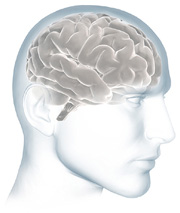
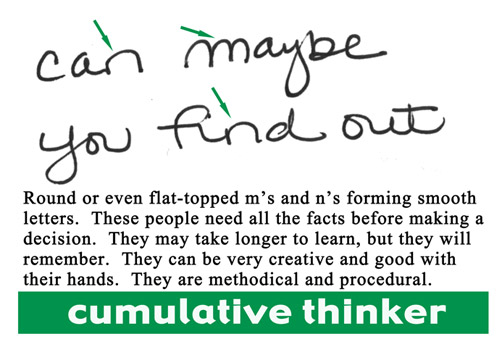
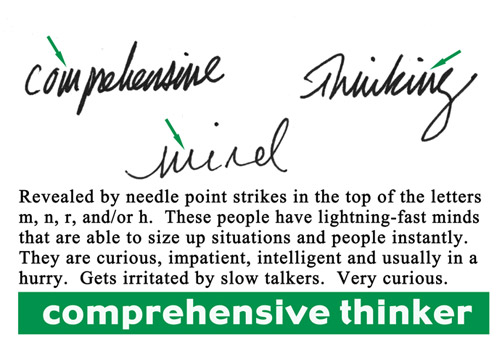
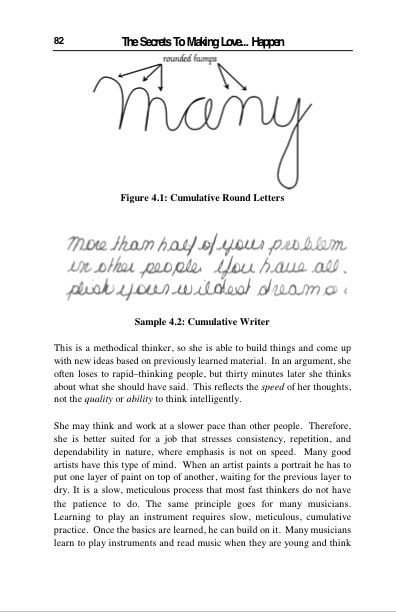
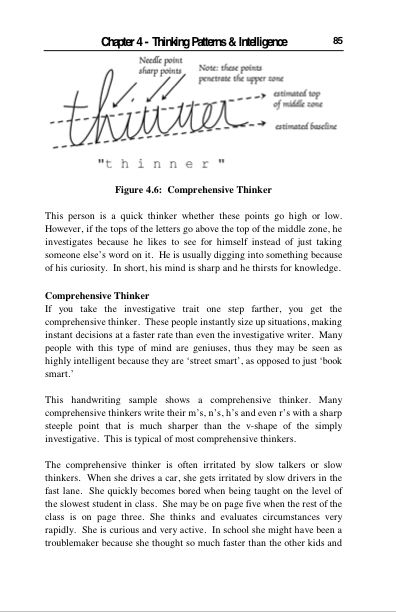




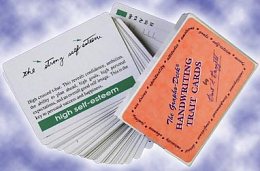
Permalink
Very interesting. Glad to be on your mailing list
Permalink
Good information at least I can correct the style my hand writing.
Permalink
As much as I practice and practice on my steno note book, there are a few things about my handwritng I just can not totally eliminate so guess I got to live with a few imperfections. And my handwriting changes during the day also. Any comments Bart on this last fact?
Permalink
there are imprefections in you just as much as you see.. so be totally aware that anything you think that is imperfect about you and you see it in your hand writting you could change it to your benefit without the need to change the (imprefection in you) ..so if you are a slow thinker its not a bad think .. it has many posetive sides to it … and so on . be the best you can be.. THINK POSETIVLY and admire the great human been you are.
Permalink
change your low bar of the T if you have it .. change what you think its effectting your success in life and effect the happiness from happinning to you. and again .. admire the great human been you are. thanks
Permalink
So wonderful information, I am very happy to be part of this wonderful team
Permalink
These information are thrilling and accurate.More power to your graceful elbow. Thanks.
Permalink
Thanks for the nice comments. We have been getting great response from this basic course. Keep studying… once you get the 101 course… it get more fun. And, if you ever get the 501 Mastery Course… it’s like art and science blending together for an amazing experience.
BART BAGGETT
Permalink
Thanks for the nice comments. We have been getting great response from this basic course. Keep studying… once you get the 101 course… it gets more fun. And, if you ever get the 501 Mastery Course… it’s like art and science blending together for an amazing experience.
BART BAGGETT
Permalink
Permalink
thanks for such a great course . though i have done Basicplus course,i enjoyed this material too
Permalink
???????? ??????????????????
Permalink
Very Good
Permalink
fascinating. Glad to know that I’m a comprehensive analytical thinker!!
Permalink
I’m an extremely analytical thinker. Always thought I was pretty quick witted, until I recently met a fellow and dated him a few weeks – he was lightning fast thinking and borderline sarcastic even at our first meeting, and teased me about being “slower”. He voluntarily wrote me some “love” letters a few weeks later, and I was not surprised to find his handwriting – very comprehensive. By comparison, I was very cumulative. Also found some very undesirable traits in his pages, and felt like the relationship would not work out.
Permalink
Good information but inadequate. probably is covered in paid course.
Permalink
my writing is slitly to the left almost straight up and dawn.